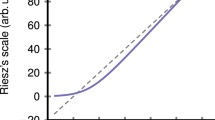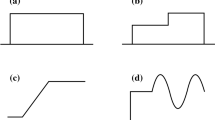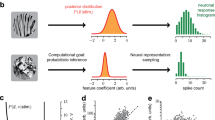Abstract
Nowhere is the sparse nature of neuronal coding more evident than in the sensory cortex, where neuronal response becomes increasingly tuned to specific features of the sensory environment. For such situations, where rate modulation schemes do not accurately describe the neuronal response to sensory stimuli, statistical descriptions based on point process events are particularly appropriate. Here, intensity measures derived from experimental data in the rat somatosensory cortex enable the direct analysis of statistical structure within spike trains, as well as inter-relationships between tactile stimuli and neuronal response. Intensity measures capture structure in spontaneous as well as driven activity, reflecting the interplay between excitatory and suppressive influences on neuronal firing. Second-order intensity estimates reveal strong dependencies upon patterns of tactile stimulation, which define the neuronal response characteristics to temporally structured stimuli.
Similar content being viewed by others
References
Ahissar E, Sosnik R, Bagdasarian K, Haidarliu S (2001) Temporal frequency of whisker movement. ii. Laminar organization of cortical representations. J. Neurophysiol. 86: 354-367.
Brillinger DR, Bryant HL, Segundo JP (1976) Identification of synaptic interactions. Biol. Cybernetics 22: 213-228.
Brown EN, Nguyen DP, Frank LM, Wilson MA, Solo V (2001) An analysis of neural receptive field plasticity by point process adaptive filtering. PNAS 98: 12261-12266.
Brumberg JC, Pinto DJ, Simons DJ (1996) Spatial gradients and inhibitory summation in the rat whisker barrel system. J. Neurophysiol. 76: 130-140.
Brumberg JC, Pinto DJ, Simons DJ (1999) Cortical columnar processing in the rat whisker-to-barrel system. J. Neurophysiol. 82: 1808-1817.
Carvell GE, Simons DJ (1990) Biometric analysis of vibrissal tactile discrimination in the rat. J. Neurosci. 10: 2638-2648.
Carvell GE, Simons DJ (1996) Abnormal tactile experience early in life disrupts active touch. J. Neurosci. 15: 2750-2757.
Chung S, Li X, Nelson SB (2002) Short-term depression at thalamocortical synapses contributes to rapid adaptation of cortical sensory responses in vivo. Neuron 34: 1-20.
Cox DR, Isham V (1980) Point Processes. Chapman and Hall, London.
Frank LM, Brown EN, Wilson MA (2000) Trajectory encoding in the hippocampus and entorhinal cortex. Neuron 27: 169-178.
Frank LM, Eden UT, Solo V, Wilson MA, Brown EN (2002) Contrasting patterns of receptive field plasticity in the hippocampus and the entorhinal cortex: An adaptive filtering approach. J. Neurosci. 22(9): 3817-3830.
Gerstein GL, Kiang NY-S (1960) An approach to the quantitative analysis of electrophysiological data from single neurons. Biophys. J. 1: 15-28.
Ghazanfar AA, Stambaugh CR, Nicolelis MAL (2000) Encoding of tactile stimulus location by somatosensory thalamocortical ensembles. J. Neurosci. 20: 3761-3775.
Guic-Robles E, Valdivieso C, Guajardo G (1989) Rats can learn a roughness discrimination using only their vibrissal system. Behavioural Brain Research 31: 285-289.
Ito M (1981) Some quantitative aspects of vibrissa-driven neuronal responses in rat neocortex. J. Neurophysiol. 46(4): 705-715.
Jarvis JR, Mitra PP (2001) Sampling properties of the spectrum and coherency of sequences of action potentials. Neural Computation 13: 717-749.
Kass RE, Ventura V (2001) A spike-train probability model. Neural Computation 13: 1713-1720.
Kyriazi HT, Carvell GE, Simons DJ (1994) Off response transformations in the whisker/barrel system. J. Neurophysiol. 72: 392-401.
Kyriazi HT, Simons DJ (1993) Thalamocortical response transformations in simulated whisker barrels. J. Neurosci. 13: 1601-1615.
Lewicki MS (1998) A review of methods for spike sorting: The detection and classification of neural action potentials. Network: Computation in Neural Systems 9: R53-R78.
Lichtenstein SH, Carvell GE, Simons DJ (1990) Responses of rat trigeminal ganglion neurons to movements of vibrissae in different directions. Somatosensory and Motor Research 7(1): 47-65.
Marmarelis P, Naka KI (1973a) Non-linear analysis and synthesis of receptive feld responses in the catfish retina. i. Horizontal cellganglion chains. J. Neurophysol. 36: 605-618.
Marmarelis P, Naka KI (1973b). Non-linear analysis and synthesis of receptive feld responses in the catfish retina. ii. One-input white-noise analysis. J. Neurophysol. 36: 619-633.
Moore C, Nelson S (1998) Spatio-temporal subthreshold receptive fields in the vibrissa representation of rat primary somatosensory cortex. J. Neurophsyiol. 80(6): 2882-2892.
Nicolelis M, Chapin J (1994) Spatiotemporal structure of somatosensory responses of many-neuron ensembles in the rat ventral posterior medial nucleus of the thalamus. J. Neurosci. 14: 3511-3532.
Perkel D, Gerstein G, Moore G (1967a) Neuronal spike trains and stochastic point processes. i. The single spike train. Biophysical Journal 7(4): 391-418.
Perkel DH, Gerstein GL, Moore GP (1967b) Neuronal spike trains and stochastic point processes. ii. Simultaneous spike trains. Biophysical Journal 7(4): 419-440.
Pinto DJ, Brumberg JC, Simons DJ (2000) Circuit dynamics and coding strategies in rodent somatosensory cortex. J. Neurophysiol. 83: 1158-1166.
Simons DJ (1978) Response properties of vibrissa units in rat s1 somatosensory neocortex. J. Neurophysiol. 41: 798-820.
Simons DJ (1983) Multi-whisker stimulation and its effects on vibrissa units in rat sm1 barrel cortex. Brain Research 276: 178-182.
Simons DJ, Carvell GE (1989) Thalamocortical response transformation in the rat vibrissa/barrel system. J. Neurophysiol. 61(2): 311-330.
Welker C (1971) Microelectrode delineation of fine grain somatotopic organization of (smi) cerebral neocortex in albino rat. Brain Res. 26(2): 259-275.
Zhu JJ, Connors BW (1999) Intrinsic firing patterns and whiskerevoked synaptic response of neurons in the rat barrel cortex. J. Neurophysiol. 81: 1171-1183.
Author information
Authors and Affiliations
Rights and permissions
About this article
Cite this article
Stanley, G.B., Webber, R.M. A Point Process Analysis of Sensory Encoding. J Comput Neurosci 15, 321–333 (2003). https://doi.org/10.1023/A:1027463810317
Issue Date:
DOI: https://doi.org/10.1023/A:1027463810317




